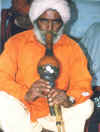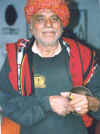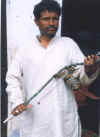|
|
the-south-asian.com August 2003 |
||||
|
August
2003 Ancient
musical Sports Karun
Chandok - the Technology Government
2 citizen Wildlife Snehal
Bhatt
Book Reviews New
research on
Tarun
Thakral & his Coke's
toxic fertiliser Bobby
Jindal - the 1st
Lehngas - a limited collection Books
|
|
||||
|
Page 1 of 2
DISTANT NOTES by Gyan Marwah
A wide variety of Indian musical instruments have gone silent and are found only in museums. Professor Shiv Shankar Prasad has taken upon himself to revive the glory of ancient organology. Old temple paintings and sculptures show that the ancient Indian musicians used almost the same kind of instruments prevalent these days. The only change is the inclusion of many newer instruments in the modern Indian repertoire - a result of the Muslim and later the British influence.
Hardcore music aficionados will tell you that even in this electronic age there is no single instrument to match the versatility of the human body. Our vocal chord is a perfect chordophone; when we pucker our lips and whistle we produce aerophonic sounds and clapping hands are the best example of an idiophone. In the ancient past the association of the body to music was sometimes extended to morbid lengths when bones and limbs began being used to make musical instruments. Khangling, the best-known religious flute of the Ladakhis, was made from the femur bone of a young girl. It was no secret that in olden times strings of the harp were made from human guts and membranes of the drums came from the hide of dead people. The idiophones are thought to be the earliest and also the first tangible extension of the human body. As these instruments were made from bones and skin, they weathered the vagaries of time. Many of the pre-historic music organs like rattles, scrapers, bull roarers and the bone flutes fall in the idiophone classification. Experts believe that most of the ancient musical instruments served four purposes – to scare away wild animals, to communicate, to pray and to entertain. Many old Indian beens [flutes], like the nag phani, were shaped in moulds of snakes and used to tame dangerous serpents. The been serves the same purpose in some villages even today. " Nobody can say with authority the exact date when the first musical instrument was invented," says Professor Shiv Shankar Prasad, an authority on ancient Indian musical instruments. " The earliest recorded evidence comes from the non-Aryan races of the Central Indian belt who used a drum called madal. This was played during prayers, used for communication between tribes and also for entertainment." In South India, experts frequently come across the word Isai meaning music in Tamil literature dating back to the second century. The musician was referred to as Perum Panar and the three instruments predominantly used were yazh [harp] kuzhal [flute] and maddalam [drum]. Says Prof. Prasad who is doing extensive research in ancient Indian music, " The Aryans came to India over 4000 years ago and brought with them their music, the earliest evidence of which is found in the Rig Vedas, the oldest of the four Vedas. It is a simple recitation of three tones -- Anudata, Svarita and Undatta. As the priests sang the devotional Vedas, their womenfolk played either the primitive bana veena or the nali [flute] and the temple's junior priest pounded on drums called dundhublis. The first recorded evidence of ancient Indian music comes from Natya Sastra, one of the most authentic and elaborate treatise by Bharata who, two millennia ago, clubbed music into three groups: Ghana [ideophone], sushira [aerophone] and tala [Chordophone]. It speaks of the great scholar’s mastery over the subject that till date this ancient grouping hasn't been bettered and even Western classical music is based on the Bharata grouping. " Once music began to be established in India, its developments were overlapped as it became an intermixture of races and cultures. While north India came under the strong influence of the Muslim styles, the Deccan and southern regions evolved their own music. Then came the tribal contribution to music in the form of ragas. For instance, Chencho Kambhoji was indicative of its relation to the Chenchus tribe of Andhra Pradesh which lived around the Kamboja area," says Prof. Prasad.
|
|||||
| Copyright © 2000 - 2003 [the-south-asian.com]. Intellectual Property. All rights reserved. | |||||
| Home | |||||


